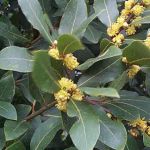| Common Name: |
Beaver Tree |
| Other Names: |
Sweet Bay |
| Botanical Name: |
Magnolia virginiana syn. M. glauca |
| Genus: |
Magnolia |
| Family: |
Magnoliaceae |
| Native Location: |
Native to E USA |
| Cultivation: |
Moist, neutral to acid, rich soil in sun or partial shade, with shelter from cold winds and late frosts. Magnolia virginiana tolerates wet soils. Buds and open flowers turn brown when damaged by frost. |
| Propagation: |
By seed sown in autumn (species only); by greenwood cuttings in late summer (deciduous magnolias); by semi-ripe cuttings from late summer to early autumn (evergreen magnolias). |
| Harvest: |
Bark is collected in autumn and dried for use in decoction, liquid extracts, powders, and tinctures. Its aromatic properties do not keep well and stocks are renewed annually. Flower buds and flowers are picked in spring (M. liliiflora) or when open in summer (M. officinalis), an d used fresh or dried in decoctions, or dried for powders. |
| Variations: |
Henry Hicks
Retains its leaves in winter more reliably than the species. |
|
| Height: |
9m (28ft) |
| Width: |
6m (20ft) |
| Hardiness: |
Z5-9 |
| Parts Used: |
Bark |
| Properties: |
A bitter, aromatic, tonic herb that increases perspiration and reduces inflammation. |
| Medicinal Uses: |
Internally for bronchial diseases, upper respiratory tract infections, malaria, rheumatism, and gout. |
| Culinary Uses: |
Leaves are used to make tea, and to flavor meat dishes and sauces. |
| Bibliography: |
Encyclopedia of Herbs by Deni Brown Copyright © 1995, 2001 Dorling Kindersley Limited Pp 269-270
|

